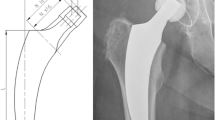Abstract
Early migration has reportedly been predictive for later implant failure. Using four different migration patterns, this study aimed to analyse migration behaviour of the two types of implant fixation—cemented and cementless—throughout the process of loosening. Migrational behaviour of 69 revised stems (49 cemented, 20 uncemented) was analysed retrospectively with EBRA-FCA (Einzel-Bild-Röntgen-Analyse, Femoral Component Analysis). Uncemented stems failed after early and late onset migration alike, while late migration was the predominant pattern in cemented stems. Mean prosthetic failure after early migration occurred 5.8 (±4.4) years postoperatively due to insufficient primary stability. Initially stable stems with late onset migration were revised after 12.4 (±4.5) years. Measurement of early migration was found to be a valuable tool to screen short-term and mid-term failure. In the long run the method’s sensitivity decreased. Late onset migration, however, preceded long-term failure by a mean of three years.
Résumé
Le but de cette étude est de rapporter les migrations précoces en rapport avec une prévision d’échec des implants. Pour cela, nous avons utilisé quatre groupes de PTH avec différentes migrations à propos du devenir de deux types de fixation des implants, cimentés ou non cimentés. l’évolution de la migration sur 69 prothèses (pièces fémorales 49 cimentées, 20 non cimentées) ont été analysées de façon rétrospective selon la méthode EBRA-FCA les pièces fémorales non cimentées peuvent présenter des échecs précoces et tardifs, alors que les prothèses cimentées ne présentent que des échecs tardifs. L’échec le plus fréquent est la migration qui se fait en moyenne à 5,8 (±4,4) ans post-opératoire en relation avec une insuffisance de stabilité primaire. Les pièces fémorales stables ont une migration beaucoup plus tardive et ne sont révisées qu’après 12,4 ans (±4,5). la mesure de la migration précoce permet de dépister les échecs à court et moyen terme. La méthode décrite est fiable, les migrations tardives cependant sont précédées d’un échec à long terme et ont évolué pendant au moins trois ans avant la reprise.

Similar content being viewed by others
References
Bauer R, Kerschbaumer F, Poisel S, Oberthaler W (1979) The transgluteal approach to the hip joint. Arch Orthop Trauma Surg 95:47–49
Biedermann R, Krismer M, Stöckl B, Mayrhofer P, Ornstein E, Franzén H (1999) Accuracy of EBRA-FCA in the measurement of migration of femoral components of total hip replacement Einzel-Bild-Roentgen-Analyse Femoral-Component-Analysis. J Bone Joint Surg [Br] 81:266–272
Eingartner C, Heigele T, Dieter J, Winter E, Weise K (2003) Long-term results with the BiContact system - aspects to investigate and learn from. Int Orthop 27:11–15
Freeman MAR, Plante-Bordeneuve P (1994) Early migration and late aseptic failure of proximal femoral prostheses. J Bone Joint Surg [Br] 76:432–438
Gruen TA, McNeice GM, Amstutz HC (1979) “Modes of failure” of cemented stem-type femoral components. A radiographic analysis of loosening. Clin Orthop 141:17–27
Hamadouche M, Witvoet J, Porcher R, Meunier A, Sedel L, Nizard I (2001) Hydroxyapatite-coated versus grit-blasted femoral stems. A prospective, randomised study using EBRA-FCA. J Bone Joint Surg [Br] 83:979–987
Kärrholm J, Borssén B, Löwenhielm G, Snorrason F (1994) Does early micromotion of femoral stem prostheses matter? 4–7 year stereoradiographic follow-up of 84 cemented prostheses. J Bone Joint Surg [Br] 76:912–917
Kärrholm J, Snorrason F (1993) Subsidence, tip, and hump micromovements of noncoated ribbed femoral prostheses. Clin Orthop 287:50–60
Kobayashi A, Donnelly WJ, Scott G, Freeman MAR (1997) Early radiological observations may predict the long-term survival of femoral hip prostheses. J Bone Joint Surg [Br] 79:583–589
Krismer M, Biedermann R, Stockl B, Fischer M, Bauer R, Haid C (1999) The prediction of failure of the stem in THR by measurement of early migration using EBRA-FCA. Einzel-Bild-Roentgen-Analyse-Femoral Component Analysis. J Bone Joint Surg [Br] 81:273–280
Mjöberg B (1991) Fixation and loosening of hip prosthesis: a review. Acta Orthop Scand 62:500–508
Meek RM, Michos J, Grigoris P, Hamblen DL (2002) Mid-term results and migration behaviour of a ti-alloy cement stem. Int Orthop 26:356–360
Nistor L, Blaha JD, Kjellström U, Selvik G (1991) In vivo measurements of relative motion between an uncemented femoral total hip component and the femur by roentgen stereophotogrammetric analysis. Clin Orthop 269:220–227
Selvik G (1989) Roentgen stereophotogrammetry: a method for the study of the kinematics of the skeletal system. Acta Orthop Scand Suppl 232:1–51
Søballe K, Toksvig-Larsen S, Gelineck J, Fruensgaard S, Hansen ES, Ryd L, Lucht U, Bünger C (1993) Migration of hydroxyapatite coated femoral prostheses: a roentgen stereophotogrammetric study. J Bone Joint Surg [Br] 75:681–687
Stoeckl B, Brabec E, Wanner S, Krismer M, Biedermann R (2005) Radiographic evaluation of the Duraloc cup after 4 years. Int Orthop 29:14–17
Walker PS, Mai SF, Cobb AG, Bentley G, Hua J (1995) Prediction of clinical outcome of THR from migration measurements on standard radiographs: a study of cemented Charnley and Stanmore femoral stems. J Bone Joint Surg [Br] 77:705–714
Wilkinson JM, Hammer AJ, Elson RA, Stockley I, Eastell R (2002) Precision of EBRA-digital software for monitoring implant migration after total hip arthroplasty. J Arthroplasty 17:910–916
Acknowledgment
All authors certify that they have no commercial associations (e.g. consultancies, stock ownership, equity interest, patient/licensing arrangements, etc.) that might pose a conflict of interest in connection with the submitted article. No funds have been received or will be received in connection with the submitted article. No professional or financial affiliations have been perceived or will be perceived to have biased the presentation.
Author information
Authors and Affiliations
Corresponding author
Rights and permissions
About this article
Cite this article
Kroell, A., Beaulé, P., Krismer, M. et al. Aseptic stem loosening in primary THA: migration analysis of cemented and cementless fixation. International Orthopaedics (SICOT) 33, 1501–1505 (2009). https://doi.org/10.1007/s00264-008-0701-1
Received:
Revised:
Accepted:
Published:
Issue Date:
DOI: https://doi.org/10.1007/s00264-008-0701-1




